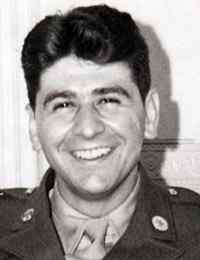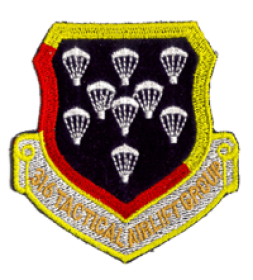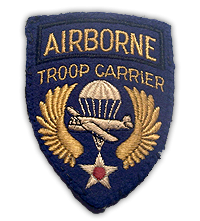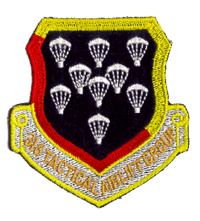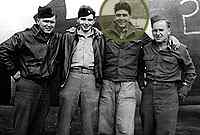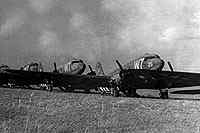Staff Sergeant Michael N. Ingrisano, Jr, ASN 12129759, born in Brooklyn, New York, March 28, 1921, enlisted at Whitehall Street, New York City, September 3, 1942. After basic training at Miami Beach, received training as a Radio Operator Mechanic in Chicago, Illinois. First assigned to the 72nd Troop Carrier Squadron at Alliance Air Base, Nebraska. Joined the 37th Troop Carrier Squadron, 316th Troop Carrier Group in El Kabrit, Egypt, on August 17, 1943. Remained with the 37th for the rest of his military career. Was honorably discharged on September 3, 1945.
During 21 months overseas, Ingrisano flew approximately 1500 combat hours. He earned Air Medals for Normandy (Neptune), Holland (Market Garden), and Germany (Varsity). He wore nine battle stars, and three Presidential Unit Citations.
Market Garden, D-Day, Sunday, September 17, 1944.
My C-47 was serial number 43-15510. Marked with W7, Field Number 25, Tail Letter "F". For this mission, we were Chalk Number 24, to drop members of the 505th Parachute Infantry Regiment, 82nd Airborne, (The same that we had dropped in Sicily, Italy, and Normandy), from Serial A-7 on Drop Zone (DZ) "N." Actually the lead plane in our serial from the 44th Troop Carrier Squadron, led the parade, dropping General James Gavin. Lift off time from Cottesmore RAF Air Base was 10:35 hours.
My crew, as it had been on D-Day Normandy, were:
- Lt. Bill Prindible (pilot),
- Lt. John Harmonay (co-pilot),
- Technical Sergeant Julius Ziankiewicz,
- and myself as radio operator.
The weather was perfectly clear when we reached landfall on the Holland coast at approximately 12:15 hours. We dropped 685 troopers and 270 parapacks at DZ "N" near Nijmegen at approximately 13:15 hours. As I recall, we encountered rather little flak but all I that I recall was voiced in a letter written to my fiancee, Bette Hill, that evening when we got back to Cottesmore. "As tired as I am and as busy as I have been, I must write to you this evening. It has been a few days since I've written but I am sure a sort of reassurance will make you feel better. Right now all the past seems so far beyond. (I might as well be honest, I'll be damned if I can concentrate,) I want to keep on saying, 'I love you.' 'I love you.' and keep repeating it over and over again without saying anything else."
D+1, Monday, September 18, 1944
The same aircraft, T/Sgt. Clete Carmean, my regular crew chief was the only change in crew, and this time we were Chalk Number 7. This was our first combat glider tow, and the 37th led the 316th Group. We towed elements of the 82nd's 319th Glider Field Artillery to Landing Zone (LZ) "T" near Groesbeek. As we neared the coast of Holland, I saw flashes from the Schouwen Islands which I later learned were the famous German 88 MM cannons. They fired at a regular pace at no one particular target because the resultant flak easily penetrated the aluminum skins of the C-47s, and the canvas skins of the CG-4A gliders.
As we went down the Maas River, I recall seeing American fighter planes attacking barges on the river. But when the fighters departed, I remember the tops of the barges sliding back and there were German gunners playing their tattoo on our crafts.
But for me, the worst was yet to come. Just prior to dropping our glider, I was seated in my RO position, which was behind a storage compartment where we kept our parachutes, and the co-pilot's position. Suddenly there was a rapid burst of fire which seemed to penetrate right over my head. I jumped up, went over to the vacant navigator's position, and looked out and down from the small window at that position at the Germans who were firing at us. I remember the one who seems to be hitting our craft. He was blond, (had no helmet on) had a big smile on his face, and every time that he squeezed the trigger of his Schmeisser, the bullets pierced our cabin. (In his book, "It Never Snows In September," Robert Kershaw shows pictures on pages 158-159 of German gunners firing at C-47s. I could swear that one of them was the guy that was giving was a good pasting.) Except for the holes in our plane's skin, all of us were untouched, physically.
In my September 20 letter to Bette, I wrote, "It has been days since I wrote to you. I don't know exactly how long because my mind has been slightly befuddled..Wish I could tell half of the things I am doing so that I can make some thing of my letters. I have been so 'geared up' lately that I can't even think straight. I should have a million and one things to say but I am so fidgety I can't sit long enough to write."
D+6, Saturday, September 23, 1944
This was our last combat glider tow. Again we towed elements of the 82nd's 325th Glider Infantry Regiment. I have no record of our Chalk Number, but the crew remained the same. My 43-15510 was repaired and flyable. Our target was LZ "O" in about the same area as the first tow.
All I recall is that as we neared the LZ, we were hit by small arms fire. I jumped up and moved toward the cockpit. A shell came through on the right side of the plane. It sparked so that I instinctively moved my head to shield my face with my right hand, just as the missile passed by my hand and exited through the top of the fuselage.
Immediately upon releasing the glider, Lt. Bill Prindible nosed down at full power to head home on the deck. Just ahead of us was a German machine gun nest facing away from our line of flight. Bill told me to release our tow line (which was 300 feet of nylon, with two large shackles, one on each end fastened to the plane and to the glider. When the glider cut loose, the rope remained for us to let loose.) on his command so that we could "get ourselves a few Germans." Our towline was right on target, but we will never know if we got our Germans!
On the next day, Ziankiewicz came to my barrack and asked me to join him on the flight line where our plane was being repaired. He showed me a hole in the left wing gas tank where a 20mm shell had penetrated the tank but had not exploded!
On Sunday, September 24, I wrote Bette that it was "A beautifully miserable Sunday afternoon, nothing to do and for the first time my mind feels perfectly relaxed. Relaxed enough to be able to write a decent letter..While I was in church this morning, I was aware of the fact that this last week was the longest in my life. For the first time, I was able to look back over the week and it seemed like an eternity since I went to Mass last Sunday, Now I feel so relaxed everything seems like a bad dream."
D+9, Tuesday, September 26, 1944
We flew into Keent, near Grave, with troop replacements and supplies. I have no records but I am sure we flew the same crew. This mission was basically flown by the 52nd Troop Carrier Wing, of which the 316th was a part. Wing aircraft were in the air from midday until 2000 hours. The landing strip, a large flat piece of grassy ground, was formerly a German emergency airstrip. The conditions were so precarious that ground forces were organized to land, unload, and reload to get serials of 36 planes airborne before the next serial moved in. For over fifty years, I told the story that my plane was the last in line. If we had not gotten off the ground when we did, we would have been taken prisoners because the Germans soon recaptured the area. I was convinced of the truth of my recollection, until Jan Bos, a native of Nijmegen, came to the States to do research with me some time in 1996. He stayed with us and he presented me with a gift, a picture of my aircraft.
There she was, W7, No. 25, on the ground at Keent, and one can count about eleven or twelve planes behind her. So much for memory! And so on September 26, I wrote to Bette: "Good Evening.Although I should crawl, if I can make it into the sack, I must write to you before I retire.There are a million and one things which I thought today-A million of them cannot be explained because of that 3rd person, the censor."
Mike Ingrisano
